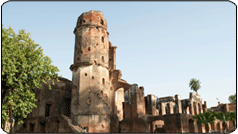Residency, 1857 Museum
Independence Day (15th August) and Republic Day (26lh January) are synonymous with the hoisting of the country's national flag at various establishments throughout the length and breadth of the country. However, it should be borne in mind that there is an elaborate and strict etiquette stipulated for the use of national flag of a sovereign country. For all official buildings it is mandatory that the flag should be flown only between sunrise and sunset, and that the brisk hoisting and slow lowering of the flag should be done ceremoniously. The flag may be flown at night, but only on very special occasion.
Interestingly, the British who appear to have been the originators of such rules which were followed all over their vast empire around the world, made an exception when the Union Jack was kept flying day and night for 140 days in the first instance and for more than 89 years thereafter, at one place.
Can you guess the singular place where this exception was made? It was at Lucknow and the building on which the Union Jack was kept flying as such was the British Residency. In the first instance it was from July 1 to November 17,1857, during the Siege of the Residency complex when the rebellion against the British was at its peak. (The siege actually ended on September 25,1857, but the British, after evacuating the besieged men, women and children, predominantly British, officially abandoned the Residency on November 17, 1857, when they felt they would not be able to hold back the rebels whom we acknowledge now as freedom fighters who were led by Begum Hazrat Mahal, the wife of the illegally deposed King of Awadh, Wajid Ali Shah). In the second phase of re-occupation of Lucknow, the British captured the Qaiser Bagh palaces and Residency on March 16, 1858. It was thereafter that the Union Jack was kept flying day and night, on the west side tower of Residency, for more than 89 years, till the afternoon of August 13, 1947, when Mr. Ireland, the caretaker of the Residency lowered the flag at a solemn ceremony. The flag was then handed over to Major General Curtis for being preserved in England.
However, the Indian tricolour could only make a showing at the Residency tower after 50 years, on Independence day in 1997, when the Deputy Superintending Archaeologist of the A.S.I. (Archaeological Survey of India) Mr. S. Jamal Hasan raised the Indain flag at the same place where the British Union Jack had been kept flying day and night. (As the adage goes 'better late than never').
The main Residency building at Lucknow was constructed by Nawab Asaf-ud-Daulah and was made available to the British Resident in 1780 for being the guest of the Nawabs. The elevated site besides the river Gomti had been selected for the British Residency in 1775 (when the Nawab shifted his capital from Faizabad to Lucknow). Initially the Resident had his office, treasury and residential houses for the staff in thatched buildings, but after the construction of the main Residency building, many other flat roofed buildings were constructed, along with a boundary and several gateways for the complex. However, people began calling the whole complex as Residency or Baillie Guard, for its main gateway towards the east (which was constructed later).
The complex had, in 1857, more than twenty-five big and small buildings, many of which were destroyed late; by the onslaught of canon fire and mining activities of the Indian freedom fighters. It was and is even today surrounded all around by trees and gardens.
The buildings that are extant in the form of ruins in the Residency complex include the main building (which was originally three storeyed and had hexagonal towers on the east and west corners (towards the riverside), the Banquetting Hall, Dr. Frayers House, the Treasury House, Begum Kothi and the Baillie Guard gateway. All these buildings were made in the European style and were modest and quite ordinary, in comparison to the Nawabi structures in the city (whether built in the traditional or the European style). The Residency complex and the ruins contained therein were preserved by the British as a momento of the courage, endurance and suffering of the European men, women and children, many of whom lost their lives during the Siege. It has the memorials of Sir Henry Lawrence, Major Banks and others killed in the compound [or elsewhere e.g. Neil] during the struggle of 1857-58.
There was a church [called St. Mary's Church] built there in 1810 [according to some accounts] but now the floor and walls that rise to a metre or so are only there to give an indication of its earlier existence. It is now surrounded by a cemetery for those Christians that died there during the Siege.
There are two buildings in the complex, an Imambara and a mosque constructed in the traditional Indo-Sarcenic style. The Imambara known as the Imambara of Sharaf-un-Nissan (for its builder) is nearly 150 years old, yet the excellent floral designs on its pillars and walls which are seen today, illustrate the height of craftsmanship of stucco art that was prevalent in Awadh architecture.
The occupier of the Residency, the British Resident, was a representative of British East India Company and was always treated as a guest by the ruling Nawabs and Kings of Awadh. Once, when the residents of the British Residency proposed to pay for the repairs of the Residency buildings, King Wajid Ali Shah declined, commenting that it would detract him from his dignity. In 1829, a retinue of 146 servants, gardeners, blacksmiths, elephant keepers etc. was there for the comfort of the British guests and for the maintenance of the Residency buildings. In 1841, the Resident had twelve elephants from the King's filkhana (elephant house) at his disposal for his sawari, apart from camels, horses and footmen for escort. The last King of Awadh, Wajid AH Shah was paying Rs. 60,000 annually for the Resident's expenses, incurred on the comfort and conveniences of his British guest, who according to Governor General Warren Hasting's proposal made to Nawab Shuja-ud-Daulah at Faizabad in 1773, was there as a man of his confidence 'to stay near his (Nawab's) Person'(sic) and be there 'for the sake of perpetuating and strengthening the good understanding and friendship that had so happily begun'. Indeed, as an author (Rosie Llewellyn Jones) has used the phrase for the title of her book on Nawabi Lucknow and the British, it was 'A Fatal Friendship', since it culminated in the guests, finally usurping the kingdom of their friendly host, in February 1856.
Source:
Hindustan Times, City Scan, A Time in History
Wednesday 21.1.1998 — Tricolours maiden hoisting at Residency

